On Tuesday, September 10, 2013, after a looooooong time in Iquique we head north towards Peru on the RN5.
For the next 200 km there is not much to see, just desert and sand and the odd abandoned Saltpeter mine ......
Around the Officina Angela some reforestation has taken place.
We are surprised that the trees survive out here.
We reach the Quebrada de Chiza and over the next 20 km the road descends from approx. 1300 to approx. 300 m above sea level.
The temperature also drops form 30 °C to 20 °C ......
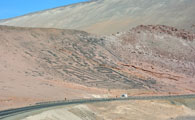
We come past the Geoglyphos de Chiza.
Then the road drops some more to 100 m above sea level.
We cross the Rio Camarones and on the other side have to climb again.
The road is under construction.
We have to wait quite a while before we can continue travelling.
But it is worth it, the RN 5 is in excellent condition.
The Valle de Camarones is green and has some irrigated fields.
We reach 1300 m above sea level again and decide to stay at this height for the night .... the first step in acclimatisation.
After 5 weeks at sea level we will have to take it easy otherwise Arequipa and the mountains could become a nightmare ......
On Wednesday morning we continue on and soon reach the Cuesta de Chaca.
Thick fog covers the valley.
The road takes us down to 250 m above sea level again.
The Valle de Chaca is green and full of plantations.
After crossing the Puente Chaca we reach another construction site.
This time we are the first vehicle and can watch the process.
At each "danger spot" e.g. bulldozer at work there is a flagman that checks that work is not endangering the passing traffic.
And up the hill it goes again ...... but this time only to 650 m above sea level before the final descend to Arica.
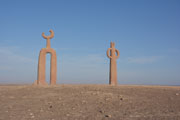
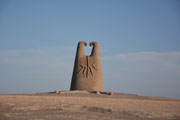
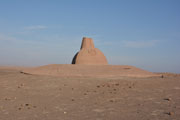
We come past some "art in the desert" .....
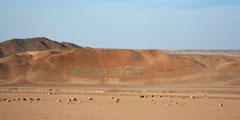
... and the "Geoglypho Coca Cola" .....
We didn't know that the company was founded by the Incas .... or do we confuse it with "Inca Cola" the horrible, yellow, sweet, favourite drink in Perú .....?
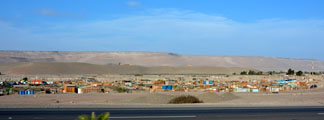
Then we reach Arica.
On its outskirts we come pass some "chosas", slums.
They are the first ones we see in Chile ....
We past Arica and reach the border.
First we have to go upstairs to the canteen or Casino as they call it here to buy the required paperwork, a form with 4 pages for 500 Pesos (approx. 1 AU$).
With the filled in form we queue up and wait for our turn at one of the 12 immigration office windows.
Even though there are busses coming and going it goes quickly.
The first page of the form is stamped and kept by the officer.
The second form gets a stamp too and we are sent to the vehicle section.
There the second form is removed, our temporary permit cancelled in the computer system, the third form stamped and we are sent off to Peru.
At the Peruvian border we have to go to the immigration counter first.
They grant visas for people for 180 days but for the vehicle for only 90 days .....
We would have liked one for 180 days for the vehicle too as we will be leaving to Switzerland and don't know yet for how long we will stay, but all talking does not help, 90 days is the maximum.
Next we have to get the quarantine officer with the blue jacket which checks the OKA for fresh produce.
He wants to see a few cabinets more to be sure that we don't smuggle stuff but soon he is happy.
Next is the customs officer in the black uniform.
He asks a few questions, wants to see the bikes and tells us to have it listed under "notes" on the temporary import permit.
Next we are sent to the CIM office.
The officer there is not too used to the computer.
As Susi is the owner of the OKA he has to fight with her long name of Susanne Myrta Schönsleben-Vogt ...... try to find an "ö" on a Spanish keyboard!!
Then the OKA is not in the database ..... so we choose "Opel" like they did in Argentina.
Next problem is the domicile ...... Australia does not appear as selection in his database ...... so we decide to choose Switzerland as we have a Swiss passport.
Next he wants to know how much the vehicle is worth ..... 10'000 US$ or even 12'000 US$?
As it is a wee bit more Susi tells him to put 20'000 US$ ......
Then the computer system fails and the poor guy has to re-enter all from scratch......
Finally we get the form and make it back to the OKA.
There Susi picks one of the customs officers and ask if with all the errors on the form we should go back to the officer and have him redo it ......
The officer asks if the chassis number is correct.
Yes
So leave it ..... that is all we check anyway .....
Let's hope he is right ......
For the ones who don't know us and our history:
As a child for eight years Susi grew up in Lima so she knows Perú a bit .... for her this trip is a kind of "coming home" .....
The first thing she tells Ruedi after entering Peru is that we should watch our belongings very careful because lots of Peruvians don't take it very serious with "mine" and "yours" or in other words: Stealing is a very common here.
Then we drive to Tacna for some shopping.
The GPS does not show too much choice so we are happy to see signs to the Plaza Vea.
We even find a parking spot nearby in the view of the shopping centre and go shopping.
After getting back to the OKA and stowing the goods away Ruedi wants to get into the driver's cabin .....
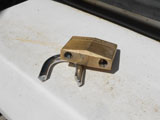
..... and sees that the door is not closed properly and the padlock lies on the floor .... broken open ........
Also the entry door lock had forcibly been turned open using a screw driver.
Yes ........ we have been robbed ..... the first time since we travel ......
Susi's photo backpack containing cameras, binoculars, glasses, etc., is gone as well as Ruedi's GPS and his pouch with his phone, sun glasses and his purse with credit and debit card ...... all gone .....
Luckily the thief had been disturbed in his "work" so the second
GPS is still in its holder, the Sat phone too and the monitor of the reversing camera is still hanging on its cable .... already half ripped out ......
The thief also tried to remove the monitor of the navigation computer but did not get far.
For whatever reason Susi had taken the small Nikon CoolPix camera into her pocket.
So for the rest of our trip this will have to do for photos ..... in Switzerland we will get new equipment.
First thing now is to get to an open space where we can call the bank with the Sat phone and have the credit and debit cards blocked.
As we are sitting in the back-section and are calling the bank we hear a loud bang up front.
The side window on the driver's side has shattered ....... the thief had tried to smash it but did not manage as it is laminated but the window now had strain on it and broke as the sun was shining on it .....
Then we visit the police and have a report done.


It takes quite a while and Susi also has to "sign" it with a finger-print.
Next stop is the window repair shop.
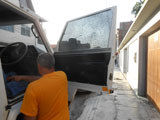
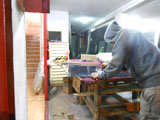
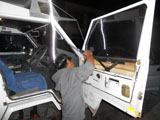
Luckily they work till late and by 8 PM the OKA has a new window and we drive out of Tacna ......
Ups, stop, we need fuel!
We head back into Tacna and stop at a Grifo petrol station.
The fuel is 13.46 Soles (around 4 US$) ..... we almost get a heart attack!
That is as much as we paid for the roast chicken for lunch!!!!
If the fuel is that expensive we cannot afford Peru!
We check again and the lady confirms the price.
We wonder how the Peruvians manage to drive around with Diesel prices like this.
Then Susi sees "per gallon" ..... ufffff ...... that's much better.
Fully fuelled we leave Tacna on the PE-38 in northerly direction.
We want to reach some altitude again.
Some 20 km out of Tacna we find an abandoned quarry and close to midnight fall into bed .....
On Thursday morning we get organised.
Luckily we always keep the second last version of important things in the emergency box.
Soon the old GPS is hooked up, Ruedi now uses clip-on sunnies (or "Mickey Mousers" as we call them because if one does flip them up it looks like the ears of Micky Mouse ....) and we are ready to go.
We have prepared a track to Arequipa that will take us through the mountains but not too high, so we can get used to the altitude again before reaching Arequipa.
So we continue on the PE-38 towards Tarata.
Soon the good bitumen road
winds its way through a canyon up into the mountains.
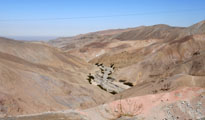
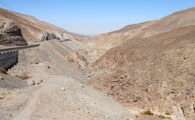
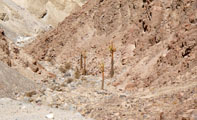
It looks like every so often the now dry river can bring quite some water!
A pretty sort of cacti grows up here ..... they look a bit like candelabrums .....
Only some 55 km from Tacna we already reach 3000 m above sea level.
That is a bit faster and higher than we had expected ....
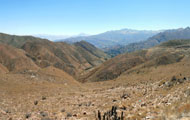
A few km later we reach the pass with 3520 m altitude and get a first view of the snow-capped volcanoes around Arequipa.
Then the road winds its way into the valley again.
In Estique Pampa we are back at 3000 m altitude.
We come past the first police checkpoint but they just wave us through.
The small town seems to concentrate on wood industry.
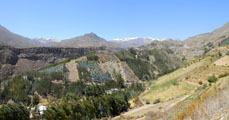
The government is maintaining the acequia systems (irrigation channels that run along the hillsides distributing the water to the cultivated areas).
This system was implemented by the Incas and is still in use in wide parts of Perú.
Crews can be seen cleaning and repairing the channels.
The acequias are the backbone of the economy out here.
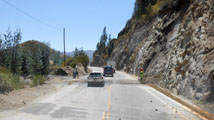
Along the road we see people maintaining the road.
They have motorbikes and all wear yellow uniforms ... new ones ..... looks like the government has created some much needed new jobs in the countryside.
One funny thing that we notice is that they all carry a fire extinguisher on the motorbikes.
Around Taraca agriculture takes over.
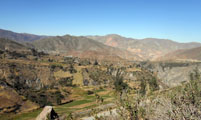
The steep hillsides are terraced ...... much of it probably dating back to the Inca time.
After Ticaco the good road ends ..... and shortly after then the road is closed.
They have had a rock slide and are now blowing the fallen rocks away.
There is no way to get through today.
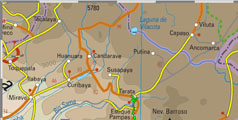
Now we have the choice:
- we can return to Tacna and drive north until we can re-join the dirt track a bit further north ..... quite some extra km ..... or
- we can drive towards Capaso on a dirt road where we should reach bitumen again ..... but that would mean that we will get into the high mountains ......
We opt for the track to Capaso but decide to ask some locals about the condition of the track first.
We don't have the experience yet to judge the tracks in Perú and don't want to get caught on a track that is too rough high in the mountains!
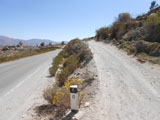
Shortly before Tarata we find the turn off ..... it really is a dirt road ...... and small too!
Quickly it climbs up the hill and we reach 3400 m altitude.
(So much for our plan to sleep at approx. 2800 m above sea level and get used to the height slowly ...... !)
As it will continue climbing we soon decide to call it the day and stay on the side of the track for the rest of the day and the night.
We have to get used to the altitude first before we can go any higher.
While Susi pre-cooks food Ruedi works on a small electrical problem the OKA has: the alarm beeper that indicates that the lights are on does not work anymore.
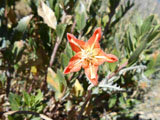
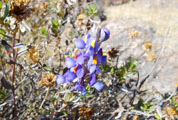
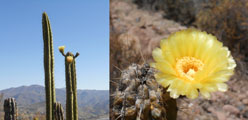
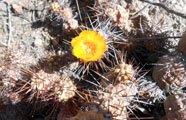
Then it is time for Susi for some "flower-hunting"....
A ute from a security company comes down hill.
Susi stops them and asks if the track goes straight through to Capaso and in what condition it is.
They confirm that it goes through but that it will be a bit rougher .... but they reckon we should be able to get though without problems.
Later on Susi gets a headache, a typical sign that she has a problem with the height.
But with a bit of Coca-tea (not Coca Cola, tea with Coca leaves in it ........) she can fall asleep without a problem.
During the night we both think about the track that lies ahead of us.
On Monday morning Ruedi expresses that he does not feel comfortable with driving this track now.
a) we have a 4WD that should only be used in emergencies due to the worn drive shaft at front that still should be exchanged
b) he also has a slight headache and is also not used to the height yet
So we decide to return to Tacna and take the long way round.
When Ruedi wants to pump up the tyres the OKA does not give a sound when Ruedi turns the ignition key ..... not even a "click"!
Patience ..... let's think what we did yesterday ......
Ruedi had been playing around with the cables and must have shortened the OKA somewhere ..... but where .....?
Ruedi decides to start with the easy task: checking the fuses ..... and strikes it lucky, it is the one of the ECM and the immobilizer!
Then the next problem shows up:
As Ruedi turns the window down on the driver's side, the one that had been smashed and repaired, it falls out of the sliding mechanism .....
The holding mechanism was glued onto the window in a wrong position.
Now we definitively have to return to Tacna and have the window fixed.
Call it destiny or what ever you want (... we call it "OKA" ....) but the sign is clear: we should not drive this small dirt track right now ....
By now we are used to having a vehicle that chooses the tracks it wants to be driven on.
We have stopped defining large routes as they will change anyway ..... we basically go where we find the workshops and the spares we need for the OKA ......
So we head back to Tacna.
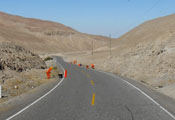
On the way we see some more road crews ...... equipped with wheelbarrow and shovels .... but it does the job, the road is clean and has no holes.
We are impressed with the quality of the roads we have found in Perú so far.
It has not much in common with the tracks Susi has in her memory ..... mind you, it is more than 40 years ago since she was here ......
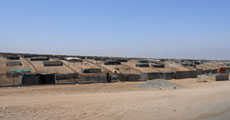
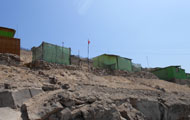
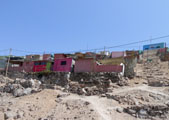
We reach the outskirts of Tacna and now can see the area where we drove through at night.
It is typical how the cities grow in Perú:
First a "chosa" is built, a shack made from cane matts.
Then a Peruvian flag is placed on the roof which makes it a house in the eye of the law.
Then some paint is applied and slowly the matts replaced with wood or bricks.
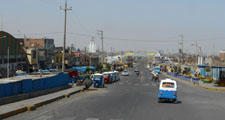
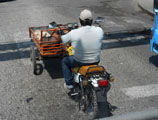
In Tacna we see many small 3-wheel motorbike-taxis, "tuck-tucks" as we know them from Thailand.
Also 3-wheel motorbike transporters or
Trimotos as they call them are common.
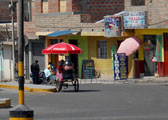
And the
"tricyclo" as Susi knows it from her youth is still in use ....
We reach the shop and they try to get the window out of the holding mechanism.
But even though the Sika they used to fixate the window into its holder has not fully solidified they cannot get the glass out.
After applying a bit too much force the glass gets a crack.
As they don't have to worry about getting the glass out undamaged they now apply brute force to get it out.
Ruedi worries about the holding mechanism and tell them to go easy on it ...... but then the glass is out and gets replaced.
This time we measure the mounting position and compare it to the other window and do it exactly as the other side is.
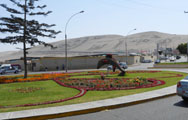
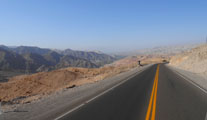
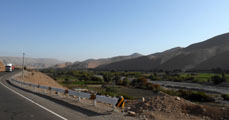
With another new side window we leave Tacna in northerly direction on the 1S.
The road is in very good condition and we can make ground quite quickly.
The road leads through some desert country ..... sand ..... sandy mountains ......
But as soon as there is water in a valley it becomes lush and green.
At Tomasiri there is a customs control.
Tacna is a tax-free zone and here they check the local vehicles.
We are just asked if we did buy anything and when we deny waved through.
Next we reach the toll station.
Funny enough only the busses and colectivos (minibuses) have to pay ......
Shortly before Locumba we reach a police control.
As it is the first control Susi goes and checks what we have to do.
The police officers are very busy.
The buses have to give identification papers from each passenger and they are then all checked in the computer.
Finally one of them finds a bit of time and informs Susi that we are not the target of the controls, we should just drive past slowly and if we are not stopped we can proceed.
So we proceed ......
We come past a solar electricity station.
The panels are aligned in such a way that always some of them are in the best position towards the sun.
Peru is a mixture of old and new, poor and rich.
The new technology is slowly spreading from the cities but out in the countryside where they are is still quite poor and traditional.
Near Ilo the landscape becomes hilly and quite nice.
Then we reach a fertile valley with a lot of cows.
We leave the 1S and take the PE-36A towards Moquegua.
It is the road to Puno and Bolivia and there is a lot of traffic on it, especially lots of Bolivian trucks.
Then we see a sign that the area around Moquegua is fruit-fly free.
We have some fruits and vegetables from Tacna but luckily at the fruit-fly check point we are waved through .....
After Moquegua the valley gets narrow and the road winds uphill through a canyon which quite steep walls.
Only cacti grow on the walls ......
At Torata we have already reached 2'200 m above sea level again.
Some 7 km late we take the PE-34D.
On our maps the dirt road is a dead end but Ruedi had checked the road on Google and it should lead us to Arequipa.
We are pleased to see a sign announcing construction work on the Moquegua – Omate – Arequipa road so Google could be right.
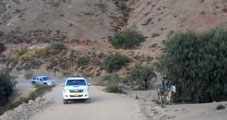
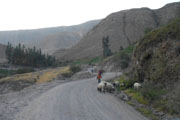
We drive down into the valley which is fertile and quite populated.
Here again the difference between the new Peru and the traditional Peru is visible.
Soon reach the beginning of the construction work.
Slowly we make our way up the hill.
The road climbs and climbs.
Our goal is to sleep at 3'000 m above sea level again.
It is getting late and the workers are going home.
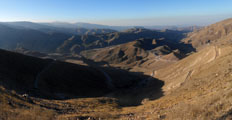
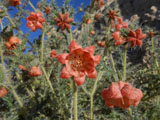
Almost at night fall we reach the desired height and also find a nice big flat area where we can stand for the night.
During the night we are surprised about the traffic that comes past .... only after 2 AM it gets a bit less.
On Saturday morning we wake up early as again there is some traffic rolling past.
It is not yet 6 AM but we can hear the construction work starting again.
We decide to drive to the top of the hill and have breakfast there.
As we are ready to leave a truck comes to our "camp site" and turns around.
We have camped on a section where they dump the excavated dirt downhill!!!
No wonder it was so nicely flattened and large .... the construction area of the road is actually closed during the day.
We reach the pass at 3'250 m above sea level and enjoy breakfast with a nice view.
From the map we know that we will drive down into a valley.
But we did not expect what we see now.
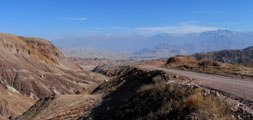
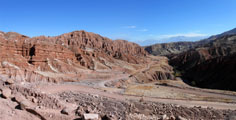
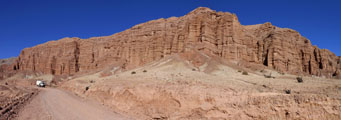
It is a very pretty deep valley with colourful mountains in varying colour.
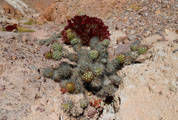
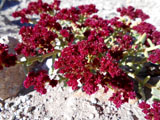
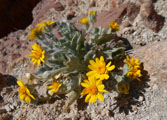
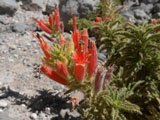
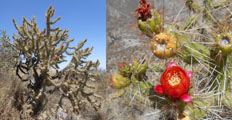
... and much to Susi's joy it even has flowers .....
We reach Jaguay Grande on a small plateau on 2'400 m altitude.
It has water and is a green spot in the dry desert mountains.
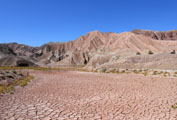
Every so often they must have a lot of rain in this area .....
As the weather is fine and the temperatures quite warm Ruedi opens the window on his side a bit to let in some fresh air.
After a few minutes he notices a crack in the new window.
The type of glass they used is normally used for windscreens and consists of two 3 mm glass panes with a security plastic foil in between.
It looks as if this glass type can only cope with the constant vibrations on the dirt roads when it is fixed into the front frame.
Then the dirt road descends further into the next valley.
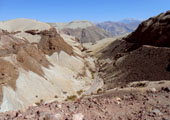
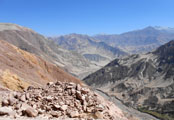
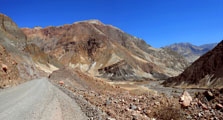
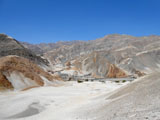
This one is even prettier!
All mountains are covered with a grey layer ..... like dirty snow.
We assume that it could be ash from one of the many volcanoes in the area ......
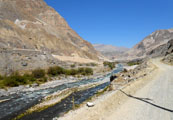
We reach the river and are surprised of the large amount of water it carries.
We have now reached 1'550 m above sea level and it is warm outside.
We continue on along the river and descend further.
At the end of the track on our map we see a sign "Camarones 200 m" and wonder ..... crayfish here???
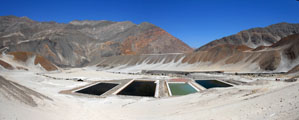
Then we see large tanks ..... aha, a farm.
Now we are convinced that there must be a road out of this valley as it does not make sense to have a crayfish farm here and having to truck them out for 150 km from 1'300 m altitude over a pass of 3'200 m to the coast on a steep dirt road.
We follow the dirt track on unchartered territory ... there are no more tracks to be seen on the GPS ......
It slowly climbs up the narrow valley past green fields.
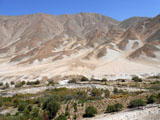
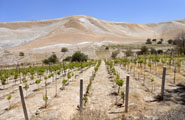
The valley opens and becomes a green oasis ..... mangoes, avocadoes, grapes for Pisco, etc. .... and as soon as the irrigation stops ...... desert ...... amazing!
After Omate, a quite large town at 2'100 m altitude, the road climbs steeply again.
The dirt track is under construction again and we worry that it might be closed.
But we get past the working crews and climb further and further.
The dirt track sometimes is quite narrow ..... and there are buses on it .....
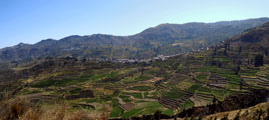
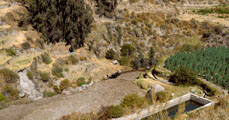
We reach the green valley of Puquina at 3'184 m above sea level.
They still use oxen to plough the fields ......
From here on the road is bitumen again.
After having reached the pass at 3'606 m above sea level the road stays at this altitude for quite a while.
Then it descends into the valley rapidly.
Some 40 km before Arequipa the construction work starts again.
First it is the road that is built and they have just closed the road off ..... no sign on where to go to ..... nothing .... so we follow the most driven track and get a bit lost .....
But eventually we reach a new bitumen road ........ that is under construction too ..... and follow it.
Luckily it is Saturday afternoon and the working crews are not working .....
Eventually we reach a road that we also find on the GPS and happily drive towards Arequipa.
But at the next town the construction starts again.
This time they seem to be replacing the canalization ..... chaos!
Ah well, we will have to get used to this .... we are not in Chile anymore ......
As it gets warm Ruedi wants to wind down his window.
At the beginning all goes well .... then the window tilts forwards and somehow gets out of its support.
Looks like they damaged the winding mechanism yesterday by using too much force .....
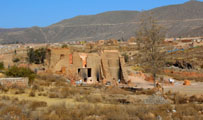
Outside of Arequipa we see a lot of brick burning facilities.
It looks like they burn the brick for the whole valley here.
Then we reach the busy roads of Arequipa.
The buses and the taxies fight for the quickest way on the road only to then stop to pick up passengers ......
A beeping horn seems to be a must when driving in Peru.
Thanks to the routing of the GPS and a track that Susi had prepared we find our way to the Hostel La Mercedes.
There are already many other overlander campers here .....
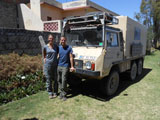
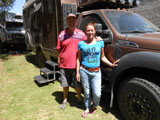
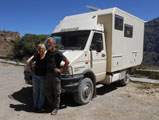
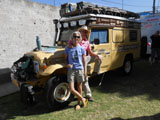
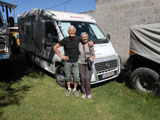
Katja and Florian with their 3-axle Pinzgauer (www.2auf4.de
), Jean Pierre and Hannie with their Ford F550 (www.jphannieontour.nl
), Heidi und Werner with their Iveco without web page but lots of time ....... Karin-Marijke and Coen with their vintage Toyota (www.landcruising.nl
), Aline and Georges with their standard camper .... proving that South America also can be done in an off-the-shelf camper ... just a bit more careful .....
We are informed that a Rotel Tour-bus will also arrive.
When the red truck shows up a bit later we quickly head into the showers before all warm water is used ....
Ruedi has a look at the broken window winding mechanism ..... yes, it is broken but he thinks that he can fix it .....
Luckily we can close the window for the night.
Then we settle in and have an early night.
On Sunday Ruedi fixes his window winding mechanism and we have a god time with the other campers.
On Monday we receive the message from Elders, our insurance, that they will replace all stolen goods with equivalent new ones.
Susi is very happy that she can buy a proper camera again.
Today we will head to the Canon de Colca.
Aline and Georges as well as Werner and Heidi also will go there.
Jean Pierre is worried that his camper will not make it and leaves early so we can help him should he get stuck.
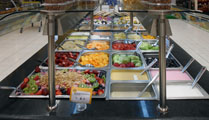
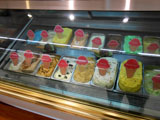
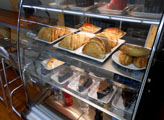
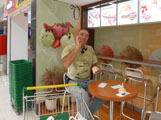
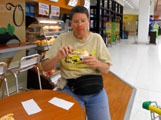
On the way out of the city we come past a large Metro Shopping Centre with a Grifo petrol station beside it.
We haven't forgotten the break in in Tacna and are a bit more careful where we park the OKA now.
But with this safe spot to park the OKA we sure enjoy the shopping ......
We leave and the bitumen road winds its way up the hill.
It is a very busy road, quite steep and it is difficult to overtake.
The oncoming traffic comes in batches ...... construction ahead?
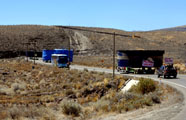
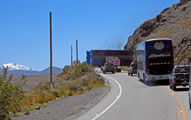
It is an oversize transport and all oncoming traffic is stopped and sent to the shoulder of the road.
Then we come past a broken down bus on our lane ..... the oversize transport trucks have to go all to the border off the road to be able to pass it ....
The road climbs further until we reach the Altiplano at 4'107 m altitude and the Vicuña zone of the Reserva Nacional Salinas y Aguas Blancas.
After we turn towards Chivay one tour-operator after the other one passes us on its way back to Arequipa.
After all, the Colca Canyon is the second or third most visited tourist destination of Peru.
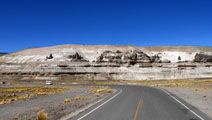
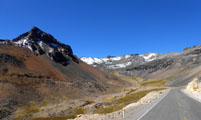
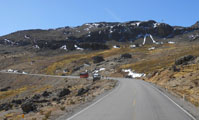
We come past some interesting formations and after some more climbing we see some snow-capped Andes.
We even reach some snow .... the tour-operators stop for pictures .....
Werner and Heidi catch up with us.
We ask them to pass us but they don't want to as they will have to drive down-hill very slowly.
Their camper (like many of the smaller ones ....) is too heavy.
As the vehicle has no engine break and the engine cannot hold the weight Werner has use his breaks a lot .....
After passing the pass at 4'895 m above sea level the excellent road deteriorates.
They have started fixing it but only got as far as removing the existing bitumen ..... so every so often there is bitumen, then a sharp end, gravel, a sharp end, bitumen ......
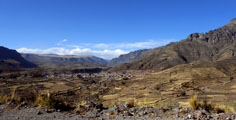
The road descends steeply.
Werner and Heidi in their Iveco fall back rapidly.
Once again we are amazed about the difference an engine break makes!
We reach Chivay and follow the dirt track down the valley.
The road is in very bad state but construction is ongoing.
It makes the going slow and we wonder how the camper of Aline and Georges is going ......
Finally we reach the mirador Cruz del Condor and are glad that Aline and Georges are here already.
Shortly after Werner and Heidi arrive too.
We settle for the night.
On Tuesday morning we wake up shortly after 6 AM.
The toilets are being cleaned and we ask the cleaners when the condors will start flying.
He looks at the mountains and replies "soon ....".
So we get to the view point and really, there are already some condors flying.
But after a while they disappear again.
Around 8 AM activity starts.
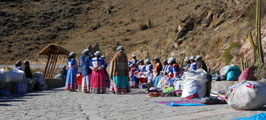
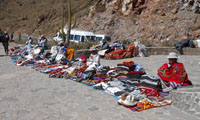
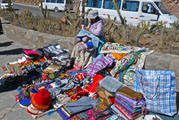
The ladies unpack their souvenirs and the tour operators arrive ..... and so do the condors!
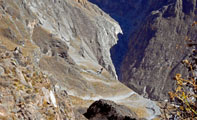
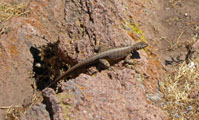
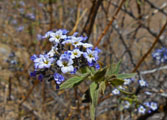
They are large and fly past quite close.
Susi is extremely frustrated with the small camera she has left.
The camera is so slow that Susi can click on the release of the camera and more than one second later the camera takes the picture .... by then the condor has already left the picture!!!!!!
So she stops taking pictures of condors and concentrates on slower moving objects .....
By 9:30 AM they condors are all gone.
We have breakfast and leave towards Cabanaconde.
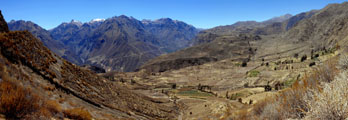
The mountains are pretty today and are a nice contrast to the terraced valley.
Then the dirt road climbs up hill again to a bit more than 4'000 m altitude.
The next valley we descend to has lots of cacti.
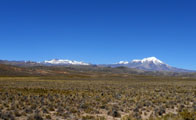
After Huambo at approx. 3'330 m altitude the road climbs up to the next pass 4'200 m altitude past some volcanoes.
Then it descends again to 3'950 m then up to 4'268 m and down to 1'514 m altitude.
As one can see altitude differences are enormous here and are always a factor to consider when planning a trip.
There is almost no traffic on this road.
During the whole day we see a motorbike, a bus and two trucks ......
We reach Majes, an agricultural town where all is irrigated.
After having driven down for hours through desert like country this looks odd ....
We head towards Lima on the Panamericana.
As soon as the irrigation stops the green fields disappear and only sand is left .........
In El Alto we see a sign for the Petroglyphs Toro Muerto and follow them.
In El Alto again all is green, plantation after plantation ..... until the irrigation stops and we reach the sand again ......
The road slowly descends.
Then we reach the edge of the tableland and start descending towards to the river.
Suddenly a Garden of Eden spreads out in front of us ...... the whole valley is one big plantation .... surrounded by sand and rocky mountains .....
Unreal!
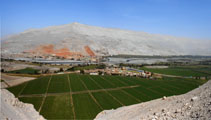
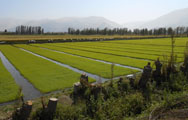
The road heads down into the valley and Castilla where we cross the river.
Rice fields are predominant.
It is weird to see flooded rice fields in Peru ..... Asia ok, but not Peru .....
We follow the signs to Toro Muerto but when we reach Corire there is no more of them .....
The GPS wants to send us onto a small dirt track .....
We ask at the service station and they confirm that this is the way.
We drive through the rice fields and through the village up the hill.
Then we reach the end of the track and find a small hut and a rubbish bin, the picnic area of Toro Muerto.
A motorbike arrives.
It is the ranger.
After a brief introduction for tomorrow's walk he invites us to sleep in front of the ranger station in the village but we rather stay up here which is fine with him.
Note to the traveller:
Should you want to visit Toro Muerto while you are still on the main road look for a small church on the left hand side (GPS S 16° 14.511', W 072° 28.195°).
Right after the church turn left.
This road leads to the village and the ranger station.
If you have a camper you can even stay for the night in front of the ranger station! (GPS S 16° 13.782', W 072° 29.190').
During the night Ruedi's back problems get worse and on Thursday morning he is not fit to get out of bed.
So Susi has a look at the petroglyphs by herself.
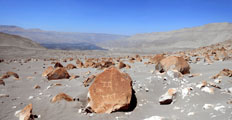
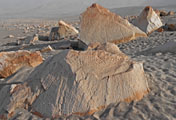
The whole valley is full of them ..... amazing!
According to the guide book the site contains some 3'000 volcanic rocks with petroglyphs which are dating back to the Huari culture.
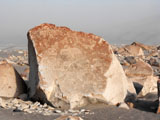
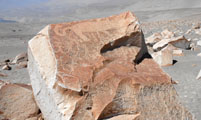
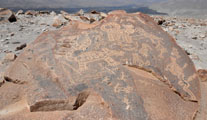
The rocks are covered with many different motives.
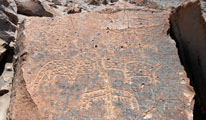
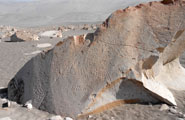
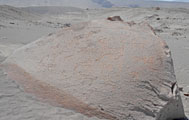
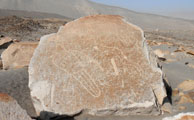
Many animals are depicted.
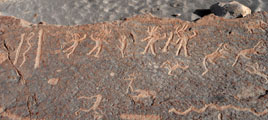
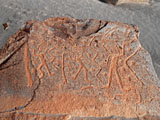
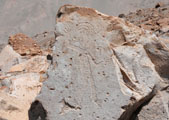
Dancing figurines appear often but also some figures with strange heats .....
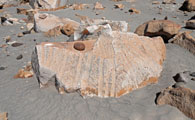
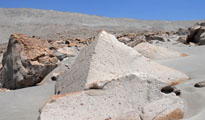
There are also rocks that were used as mills and some pyramid-shaped rocks with decorations on all sides.
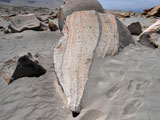
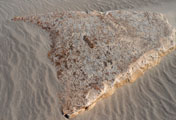
But the sand is slowly covering them .....
In the afternoon Ruedi's back starts improving and it looks as if we will be able to travel again tomorrow.
But we have now lost so much time that we will go back to the Panamericana and travel north on the bitumen.
The trip to Andagua, Valle de los Volcanes and the Canon de Cotahuasi will have to wait for a next time .....
In the far distance we see the snow-capped Andes ..... quite a bit of snow on them ...... maybe it could have been a bit too much snow for the track we had planned .....
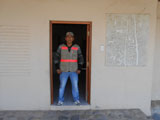
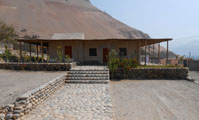
We stop at the ranger station and have a final chat with the ranger.
The spots he offered would have been nice ...
We return to the Panamericana and head in direction of Lima.
It is only 10 o'clock and already 25°C outside.
The fields on both sides of the road are full of crops.
Then the irrigation stops and we see sand again ......
After a steep descent we reach the Pacific ocean.
A few km before Camaná there is water again and the desert turns green again.
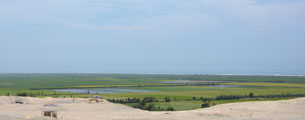
The plantations extend down to the ocean.
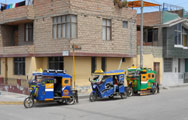
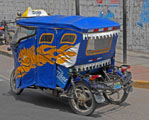
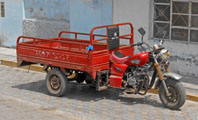
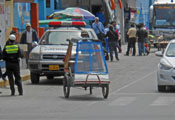
Camaná is a lively city, motorbike- and bicycle-taxis zoom around like busy bees ..... fun to watch for the passenger but a pain for the driver .....
We cross the river Camaná which brings the waters form the Colca Canyon.
The towns don't have a real beginning or an end ..... they just blend into each other .....
After crossing the Rio Haway the mountains reach down to the ocean.
The Panamericana goes inland following a dry riverbed.
The water seems to be not too far down and new farms are being established ..... mainly olive trees, each with its irrigation hose ......
The Ocoña valley is the next green valley.
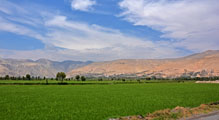
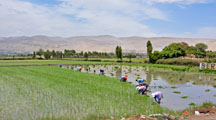
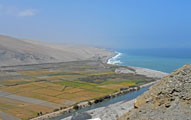
Rice is planted like they do it in Asia ......
The Ocoña river has plenty of water that runs off unused into the bay leaving the water of the ocean light blue.
The Panamericana goes along the coast up the hill and down to the river bed or beach and up the hill again and down again ......
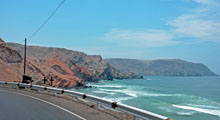
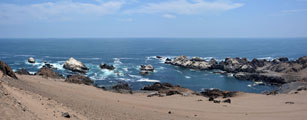
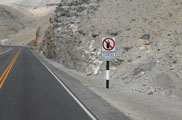
We like this road sign: Don't burn tyres on the road!
We reach Chala and some 10 km later turn off towards the ocean to stay at the Hotel Puerto Inca for the night.
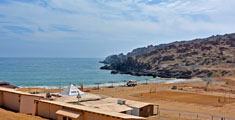
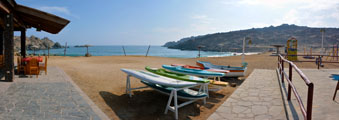
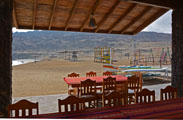
It is a lovely spot, directly at the beach .... nice!
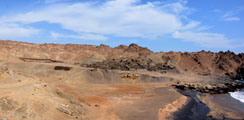
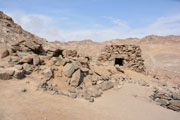
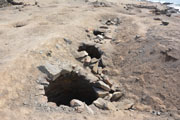
We find out that Puerto Inca or Quebrada de la Vaca is the most important archaeological site of the Coast between Nazca (Peru) and Copiapo (Chile).
The people here collected sea food and sea weed (cochallullo), dried and stored it in subterranean silos (colcas).
It was then transported to Cusco on an Inca road that runs in a straight line between Cusco and the Peruvian Coast.
On Friday the board computer does not want to start properly.
Of course we did not safe the data last night so Susi's job is to get the computer going to such an extent that we can save the data.
Luckily she manages.
Next the cable of Ruedi's exchange GPS gives up.
It had been shaky before but now it completely gives up.
Is this never ending?????
We drive along the coast and the fog does not want to lift either ....
What a day ....
The Panamericana continues .... down to the river bed and orchards .... up to hill .... down to the next river bed and orchard ... we lose track of how many rives we have crossed.
Then we reach Nazca.
Suddenly the sun is out and the temperature rises to 31°C in no time.
We reach the Nazca Lines and stop at the tower.
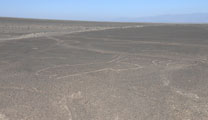
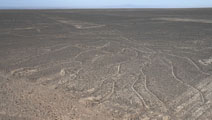
One can see the "hands" and the "tree" from there.
If you really want to see the lines you have to do it by airplane.
The problem there is to find a reputable air transport company .... it is known that there are many "crash airlines" operating in the area .....
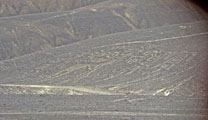
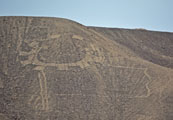
We come past Palpa, were some more lines and pictures have been found.
After Palpa the road climbs up the hill to about 450 m altitude.
From Palpa on trees have been planted along the road and look well watered.
After some more deserts we reach Ocucaje.
From here on the valley is green and we see asparagus, cotton, grapes .... they seem to have plenty of water.
We reach Ica, a large city and the motorbike-taxis make Ruedi's life difficult.
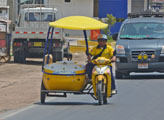
By now the temperature has risen over 30°C and gives a good reason to by a Donofrio ice cream .... Susi remembers them well from her childhood .....
She claims the "sandwich", vanilla ice cream between two chocolate biscuits, still tastes as good as she remembers it.
The next city, Chincha, is not much different ... narrow roads, much traffic, motorbike-taxis rushing around .....
After Chincha the road descends to the ocean.
Here also the highway to Lima starts.
There is no other road along the coast, one has to take the highway and pay toll.
It is also very difficult to find a spot to stand for the night.
Luckily we spot a small valley where we can hide from the traffic.
On Saturday, September 21, we reach Cañete.
It is a large town now and full of plantations.
Susi remembers the place as small town .... they used to go fishing up the Cañete valley .....
We travel north through the desert.
We come past housing estates with holiday units like Lomas del Mar, Visa al Mar, Mala, Tortoritas .....
Asia is the largest one of them with Golf court, gymnasium, large shopping mall, etc.
The closer we get to Lima the busier the highway gets.
We get the first impression of the rather aggressive "wild west" driving style the Peruvians have.
Ruedi compares it with Nairobi.
But in Nairobi there was a certain tolerance which in Lima does not exist.
South Americans are machos and this makes driving very difficult.
As previous travellers had stayed at the Club Suizo Susi guides Ruedi to this place.
But the door has been changed and we are too high to get into the parking lot.
So we continue on to Miraflores where we finally reach our "home" for the next few weeks: the Hitchhikers Hostal.
For the next few days we just relax and enjoy the peace of the hostal.
Around us is the hustle and bustle of the 9 Mio inhabitants of Lima .......
Then Susi gets in contact with her alumni and of course they want us to go out with them ......
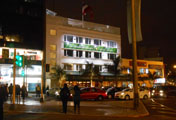
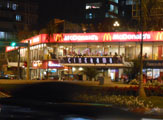
So we head to the Tiendecita Blanca.
Susi recognises a lot of buildings and tells Ruedi about them e.g. the cinema El Pacifico where she used to go and watch movies .....
In a way all has changed .... in a way it has not changed at all .....
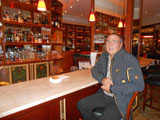
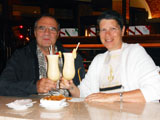
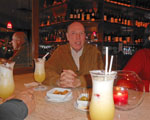
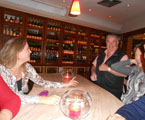
Being Swiss we are much too early ... luckily they make good Piña Colada Virgen (without alcohol) .....
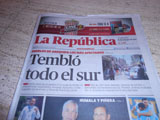
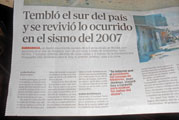
In the newspaper we also see that there had been a strong earthquake in Arequipa which also had been felt in Lima.
The epicentre was near Chala, where we had stood at Puerto Inca at the beach just a week ago .....
After another round of Piña Coladas we head to "Panchita", one of the best restaurants for Peruvian Cuisine (especially anticuchos) in Lima.
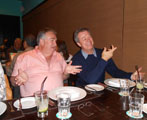
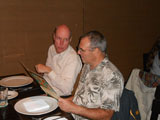
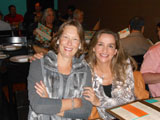

..... Alberto and Carlos ........... Peter and Ruedi ................. Monica and Gloria ................ Susi and Marisol .....
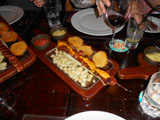
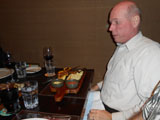
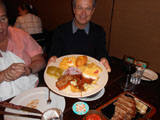
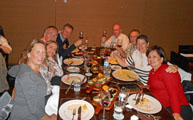
The food is very good and we all enjoy it very much.
On Friday, September 27, we leave Lima and fly to Switzerland, where we stay for close to 2 months.
The OKA stays at the save parking area of the Hitchhikers Hostal Miraflores.
Today we are back in Lima on Tuesday, November 19, and are happy to be back on our home.
And the party goes on ......
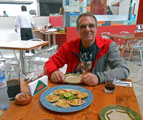
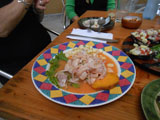
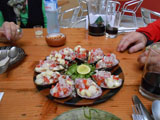
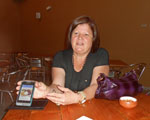
.... at "El Villano" with Sonya ..... enjoying ceviche and conchitas ....

.... at "El Pez Amigo", the best fish restaurant in Lima, with Peter and Sisy Brammertz ....
The Pisco Sour is very strong there ..... but gooooooooooooood!
Susi also finds some foods she remembers from her childhood ....
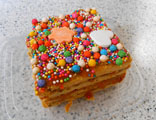
..... turon de Doña Pepa ...... and of course chicha morada, a non-alcoholic drink made from purple corn and water (boiling the corn with pineapple, cinnamon, clove, and sugar) ....
Yes, we put on some weight .... or in other words: We did not lose the kilos we had gained in Switzerland .....
The weather in Lima is very foggy and humid and the OKA has a few issues .... so Ruedi has quite some work to do.
We try to get a new side window but learn that windows of that glass type (the glass that bursts to thousands of pieces when shattered)
have to be moulded.
It is not possible to cut it without breaking it.
This would take at least 2 weeks and we don't have that time.
So we opt for an emergency window made from a very strong type of plastic (they call it Plexiglass, we know it as Macrolon).
We will carry this one with us and should the window we currently have get too much damaged we can replace it with the Macrolon one.
On Saturday, November 30., the day of the party at the ex-school of Susi arrives: 70 years Colegio Pestalozzi!
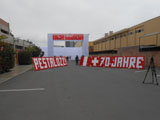
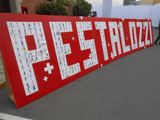
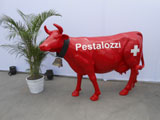
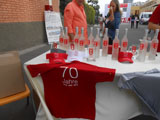
Luckily Switzerland and Peru have the same colours in their flag which makes decorating much easier!
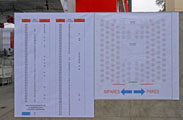
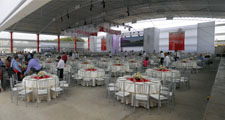
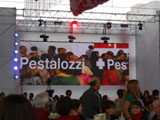
They are expecting some 1500 people and all is well organised.
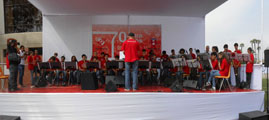
The school band plays and more and more guest arrive .....
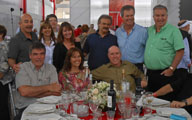
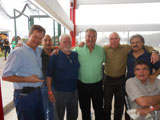
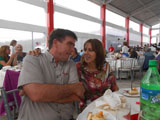
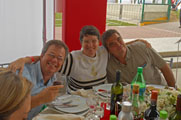
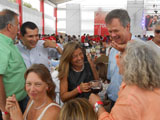
... Susi's class mates ..................... with a former teacher ................ and also students from other grades ......
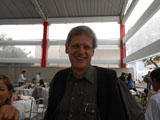

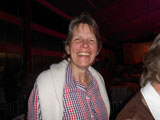
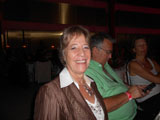
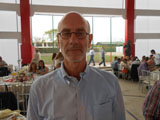
Susi is busy meeting and greeting old friends.... Martin, Ruedi and Esther Bachmann .......... Corinne Schirmer ................ Röbi Winter .... and many more .....
Time flies and soon it is time to go back to the hostal.
We want to leave early tomorrow morning ....
On Sunday Sonya comes past and brings the ordered Christmas cookies and cheeses from her Delicatessen business.
Now we are all organised!
We leave Lima and return to Iquique, Chile, where our next trip will start ....... and this is the end of this journal.
| 
![]() Created by Level X Webdesign
Created by Level X Webdesign